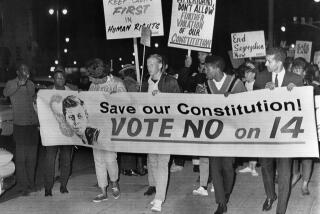In Dixie’s Land, He Took His Stand : STROM THURMOND AND THE POLITICS OF SOUTHERN CHANGE, <i> By Nadine Cohodas (Simon and Schuster: $27.50; 498 pp.)</i>
- Share via
It is hard to know where to start in writing a life as long and resonant as Strom Thurmond’s, who turned 90 recently and still sits as South Carolina’s senior senator. In fact, Cohodas begins not with Thurmond at all but with his precursor, Pitchfork Ben Tillman, the loud race-baiter who held a South Carolina Senate seat at the turn of the century, and whom Strom knew as a boy. The Thurmonds and the Tillmans were friends in Edgefield, S.C., Strom’s lawyer father being a genteel confederate for the crude politician.
Socially the Thurmonds were what Southerners call “nice people.” This means that they had enough money, but not too much, and that wherever invited they would dress properly and say appropriate things. Young Strom grew up and attended Clemson University, which Tillman had founded. He read law at his father’s office, began a successful practice and progressed quickly from county school superintendent to the state legislature and then to the Governor’s office. As Governor during the 1930s and 1940s he compiled what Cohodas assesses to be a fairly progressive record, insisting on prosecuting whites who harmed blacks and goading the legislature to approve increased school appropriations for both segregated systems.
The 1948 presidential election offers the first of two signal episodes in Thurmond’s political career. After leading a walk-out from the Democratic Convention in protest over its civil rights platform plank, Thurmond emerged as the leader of the States Rights Party, and became its candidate for president. Soon dubbed the Dixiecrats, the party carried South Carolina, Louisiana, Alabama and Mississippi in the face of Truman’s upset victory over Thomas Dewey.
Cohodas gives us a sampling of Thurmond’s 1948 campaign rhetoric:
“I want to tell you . . . that the progress of the Negro race has not been due to these so-called emancipators . . . but to the kindness of the good southern people . . . I want to tell you . . . that there’s not enough troops in the army to force the southern people to break down segregation and admit the Negro race into our theaters, into our swimming pools, into our homes and into our churches.”
By virtue of the 1948 campaign, Thurmond became a figure of national renown, a malicious bumpkin to some, but a folk hero to a number of frustrated whites. Following some time practicing law, Thurmond progressed to the Senate in 1954, where he appeared the more presentable of South Carolina’s two offerings, the other being the execrable Cotton Ed Smith.
Even though a party turncoat now associated primarily with racial issues, Thurmond faced surprisingly little persistent home-state opposition. His most dogged critics in the Dixiecrat period were Ralph McGill of the Atlantic Constitution and Jonathan Daniels of the Raleigh News and Observer, both liberal newspapermen but neither of whom sold any papers to Thurmond’s constituents. The thinness of South Carolina’s political culture, and the consensus that Thurmond was able to create within it, is so startling that one wonders if Cohodas has failed in her research. But I do not think this is the case. South Carolina in the ‘50s and ‘60s had no Atlanta, which leavened the politics of Georgia, its neighbor to the south; it also lacked the liberal universities and newspapers that often set the tone for politics in North Carolina, its neighbor to the north. South Carolina, as in the antebellum days, felt tied more closely to the Deep South states of Alabama and Mississippi than to its neighbors on the eastern seaboard. Knowing his culture, Thurmond was able to use the politics of race and resentment to aggrandize an unassailable position.
The second watershed event for Thurmond came in the election of 1968 and its aftermath. Having shifted to the Republican Party in 1964, and thus prompted the southern migration from the Democrats, Thurmond was confronted in 1968 with the George Wallace third-party phenomenon, which so aptly mirrored his own 20 years earlier. Wallace carried some of the same states that Thurmond did, but not South Carolina. Thurmond, more loyal to his second political party than to his first, was able to win Wallace voters for Nixon and carry South Carolina as well as much of the South for the Republicans. This was not lost on Nixon’s strategists. Soon after the elections, Nixon commandeered two of Thurmond’s closest advisers, Fred Buzhart and Harry Dent, to be in the White House. Together with Lee Atwater, another Thurmond disciple who joined the national party just in time for presidential politics in the 1980s, they pioneered what came to be known as the Southern Strategy. Simply stated, that strategy aimed to capture the disaffected southern white conservative vote, often with unabashed racial appeals, and engineer a historic shift of the southern presidential base from the Democratic to the Republican column.
One result of Thurmond’s prowess was to attract billions in federal largess to South Carolina during the Nixon administration. Nixon may have at times been a conservative, but he certainly knew how to use the government to help his friends. This pork barrel largess probably did more to help South Carolina than anything else Thurmond ever did, although as an old states rights man he would be loathe to admit it.
Thurmond gradually rose in power and Senate seniority, helping Reagan to win a southern majority and becoming chairman of the Judiciary Committee in 1981. Now in a governing role, one may expect to find in Thurmond’s record a distinguished piece of legislation. There is none. Searching for some bill to claim, Cohodas lamely makes the case that Thurmond, now in her view an accommodationist in civil rights, has a great deal to do with the passage of the Civil Rights Act of 1982 by not opposing it.
Indeed it is quite difficult to find much of anything that Thurmond has done that merits recording in the history books, other than the aforementioned contributions to the Republican Southern Strategy in the ‘60s and ‘70s. As the subject of a biography he is remarkable neither for his accomplishments nor indeed for his personality, which in Cohodas’ rendering seems curiously flat. Not that there isn’t raw material. He had a penchant for dating beauty queens and married late. He demonstrated his lingering virility by standing on his head for photographers. Tragedy has visited him. His first wife, whom he adored, died suddenly of a brain tumor. (His 22-year-old daughter, Nancy, was struck and killed by a car just 10 days ago, on April 15). Nonetheless, we are not treated to the musings of the inner man. There seems little to animate Thurmond in Cohodas’s telling except the relentless upward mobility of the successful pol, and the moral obtuseness necessary to deny for a lifetime that he used racial hatred for political gain.
One wonders how different the story would be if Cohodas had taken for her model a more subtle or distinguished man, such as Sam Ervin or J. William Fullbright, each of whom knew that segregation was a tragedy rather than an opportunity and sought to make his make elsewhere. Still, they are gone, or gone from politics, and Thurmond is still with us.
Ultimately, Nadine Cohodas has written a book that is larger than her subject. The most interesting parts of it are her recounting of the civil rights movement itself, and its haunting figures, such as Judge Watie Waring, Thurmond’s liberal antagonist on the Federal bench. Authors, such as Cohodas, who overtake their subject in the midst of the work can sometimes adopt a tone or a style that makes the book more powerful because of it. One thinks of Robert Caro’s treatment of Robert Moses. But here, Cohodas fails to make a good biography into a great one, because she doesn’t adopt the irony or perspective necessary to give her reportorial prose the energy to lift it past the dead weight of the man whom she describes.
But the fact that the book is not a great biography does not say that it is not a very good or a readable one. It is spirited, well-written and if curiously vague on the inner life of Thurmond it may be because there is not much there to report. I doubt the book’s claim that Strom Thurmond is a man whose changed views on civil rights represents change in the American South, because I doubt that he has changed, or is aware of it if he has. Fortunately, the claim is not made so broadly or so often that it detracts from this good political biography.
More to Read
Sign up for Essential California
The most important California stories and recommendations in your inbox every morning.
You may occasionally receive promotional content from the Los Angeles Times.













